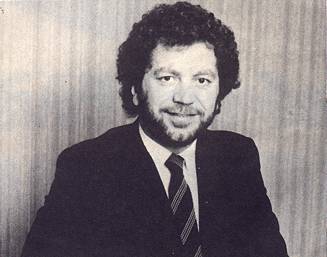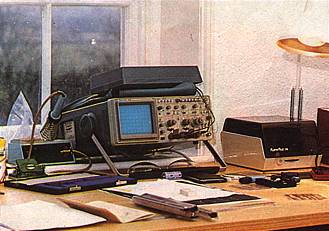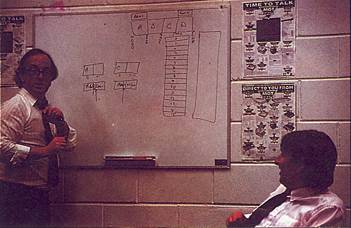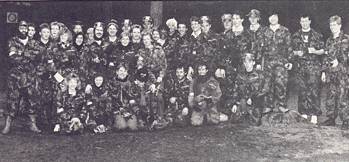GAME FOR GOSSIP
TRAGEDY HAS struck the computer industry with the news that
Bob’s Full House is not to be released (well, Domark
think it’s a tragedy). Apparently Domark negotiated a licence
which did not permit the use of Bob Monkhouse’s name or image. The lawyer
concerned has been shot. Oh well, I suppose they could always call it
Fred’s Full House! (Not unless they pay me! — Fred.)
Watch it, young man! After clipping some fans round the earhole,
Brian Clough is making a return to the Spectrum — he obviously
needs the money to pay off his £5000 fine! CDS Software are rereleasing
Brian Clough’s Football Fortunes (42%, Issue 38), a computer-moderated
board game, at the new ‘low’ price of £7.99 cass, £9.99 disk.
Yet more craziness should soon be provided by Crazy Cars II. The
sequel to Titus’ first fast driving game (65%, Issue 52) it
involves racing across four American states in a bid to smash a stolen car
racket run by corrupt policemen. 360° spins, road junctions, and road
blocks are all promised. Also imminent from Titus is Titan. Another
mad scientist has been let out of the loony bin, and set up an 80 world (!)
game which attracts the ‘wildest adventurers’. Unfortunately the game tends to
kill people who make mistakes in guiding the powerball with a magical and
magnetic bat. Although it sounds ominously like a Break-Out game,
there’s apparently some ultra-fast, omni-directional scrolling.
Mike Singleton fans will be pleased to know that he is
currently negotiating with Telecomsoft
(Firebird/Rainbird/Silverbird) about the release of the third game in the
classic Midnight trilogy (Lords Of Midnight, Doomdark’s
Revenge), titled Eye Of The Moon. The present discussion mainly
concerns which formats the game will eventually appear on — Telecomsoft seem to
want 16-bit only. But hopefully a Spectrum version of the long-awaited epic
will be released sometime in 1990. Meanwhile, Mike’s Maelstrom
Games company is working on Star Lord, a ‘massive galactic
strategy game’. All versions (including Spectrum, of course) are due out
towards the end of this year.
Another Spectrum veteran is Pete Cooke (author of Tau
Ceti and Earthlight). He’s currently tuning up the Spectrum
version of a Geoff Crammond 3-D driving game. This should be ready for release
by Telecomsoft (them again?!), ‘later in the year’.
Also hard at work for Telecomsoft are Graftgold, currently
developing the sequel to Bubble Bobble, titled Rainbow
Islands. One or two players can take part, but this time the main
characters are humans rather than cuddly dinosaurs (shame!). And instead of
spitting bubbles, the humans yawn rainbows by which they can climb up the
screens. Featuring ‘colourful vertical scrolling’ the game should be finished
by the end of April.
Probe Software have been keeping extremely busy lately,
working on no less than five Spectrum games. Two of these are for US Gold:
Out Run Europa, the turbocharged sequel to the classic driving game,
and the mysterious Heavy Metal! Probe are also busy doing a conversion
of the Mr Heli Irem coin-op for Firebird, and Trick Ramp
Crazy, for Silverbird. The fifth game currently being developed is
currently titled Crazy Jet Racer, apparently pretty darn hot it’s just
been placed with a software house — preview nex’ munf!
Wire-frame specialists, Vektor Grafix (of Star
Wars and The Empire Strikes Back fame) are currently putting the
finishing touches to an Activision game, provisionally titled Bomber.
Sub-company Sprytes are also doing several Spectrum conversions, but they’re
not yet telling us which ones!
Finally, good news for 48K owners: the ‘impossible’ has been done — Ocean’s
brilliant arcade adventure 128K-only Where Time Stood Still has been
crammed into 48K!
AMSTRAD’S NEW HARDWARE
LONG-AWAITED Amstrad hardware, such as an add-on disk drive for
the 48K/128K/+2 Spectrums, are finally ready for release. An official press
launch should have happened by the time you read this, but already some details
have leaked from Amstrad’s Brentwood HQ. Add-ons are said to include a
£199 word processor package (consisting of a rebadged PCW 8256 printer,
interface, mouse and word processor/spreadsheet software), an £89 slimline
add-on disk drive (standard 3-inch, 180K per side) and a £29 +3 ‘HQ’
system — a datasette with a special interface curing the +3’s legendary sound
tuning problems.
These new products are said to be a clear rebuff to industry cynics who said
Amstrad had abandoned the games machine market for business computers and
satellite TV. Independent Spectrum add-on makers are clearly worried about
Amstrad’s renewed interest in the Spectrum, but MGT’s Alan Miles says customers
are likely to be dubious about the quality of the Amstrad hardware.
The imminent launch of the add-ons has also started a wave of rumours about
an Amstrad ST/Amiga beater. The required technical expertise could come from
Acorn, according to several industry sources. Apparently Acorn are prepared to
provide Archimedes circuitboards at near cost price, if Amstrad agree to case,
package and market the resulting machines. Priced at around £399 the
Amstrad ‘RISC32’ would wipe out the ST and Amiga, and resulting sales would
provide substantial royalties for Acorn. Pressed on the subject Alan Sugar
would only say; ‘Amstrad have always put customers first and you can trust us
not to abandon them now.’

SAM UPDATE
BY THE TIME you read this MGT should have
finally met with software houses to organize support for their 8-bit wonder
machine; the SAM Coupé. Already they’ve had lots of
enquiries from programmers interested in writing for it, and making their
latest Spectrum games compatible with its ‘Spectrum mode’. The wider public are
showing strong interest as well. 2,000 existing MGT customers have applied for
the no-commitment reservations offered by MGT, while one foreign distributor
has already placed an order for 20,000 units. Unsurprisingly Alan Miles now
expects to easily surpass his first year target of 56,000 units sold.
Due to these expected sales MGT have begun expanding their mail order
service with the aim of eventually dispatching hardware within a day of
receiving the order. There is also likely to be an advanced technical hotline
available to users willing to pay a subscriber fee. The existing helpline will
continue, however, for normal users asking basic questions about how to get
their hardware running. MGT expect a lot more such questions if talks succeed
in placing SAM in chain stores.
Also aiming to be on the high street shelves is the Konix Multi-System
console which MGT welcome, since it also comes from Wales and is aimed at a
slightly different market. While the Konix is sold as the ‘ultimate toy’, SAM
is a serious computer, designed to appeal to the education market, technical
fans and overseas manufacturers. But at the same time it has a strong games
potential. It has 256K (128K more than the Konix), a better sound chip than the
Amiga and static graphics to rival the ST. While technical experts doubt an
8-bit chip, albeit a fast one, can run quickly enough to compete with 16-bit
machines everyone agrees the basic design is very clever.
After its launch in July, MGT plan a host of add-ons including a dot matrix
printer and monitor. There’s also to be a mouse which overwrites the cursor
controls, so it should work with games written for a joystick. For more serious
users MGT plan an ST/Amiga style WIMP system, with the mouse moving a cursor
around the screen, pulling down function menus and opening ‘windows’. For the
future MGT are considering more radical add-ons to increase the machine’s
processing power further.
RAZZ JAZZ
DETAILS continue to emerge about the arcade ambitions of
ACG, the people behind Ultimate and
Rare. For over two and a half years ACG engineers have been
developing their own coin-op hardware and now that it’s virtually complete
details are emerging about its specification. With one Megabyte of on-board
memory it is based around a Z80 ‘lookalike’ Hitachi CPU, running at 10 MHz
(compared to 4MHz for the Spectrum, and 7MHz for the Amiga).
Graphical capabilities are impressive. Although screen resolution is
relatively low (256 columns x 222 lines), up to 192 colours may be displayed
simultaneously, chosen from a palette of 260,000! High speed is ensured by a
number of hardware scrolls, and a unique shape-drawing system. One byte of
memory is used for each pixel; the bottom six bits control the colour while the
top two determine the direction the next pixel is in. This allows shapes to
easily be turned upside down and flipped sideways.
Sound is handled by a separate Jazz board (where do they get these names
from?!). This utilises stereo Yamaha sound chips with (in the current
prototype) a total of 12 channels.

Both Razz and Jazz boards will form the heart of new ACG coin-ops, including
Jon Ritman’s imminent soccer game (I can’t wait! — Phil).
But ACG aren’t alone in developing a coin-op system. Rainbow
Games, a sister company of Rainbow Arts, are currently working on a
32-bit Pluto motherboard. This allows up to 128 colours per scan line and
playfield, chosen from a palette of 260,000 (the same as Razz). Screen
resolution is programmable up to a maximum 640 x 480 pixels, and the graphic
system includes hardware zoom and turning. Sound specifications are also
impressive: 16 channel stereo.
The first coin-op to utilise Pluto will be Dark Chamber, a magical
shoot-’em-up, followed by Monster Olympics.

What’s this? Are relations between MicroProse and Electronic
Arts so bad that they took up arms?! Well not exactly, the two software houses
recently took each other on at the Combat Game. Teams from both firms armed
themselves with paint guns and went into ‘battle’. Extensive training on
Airborne Ranger enabled the MicroProse ‘Combat Crew’ to storm Electronic Arts’
base to claim victory!






